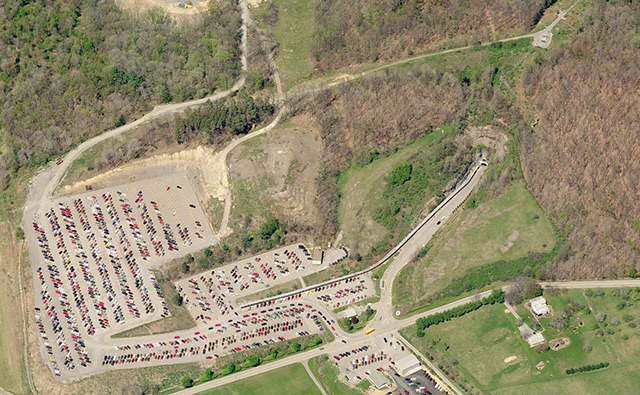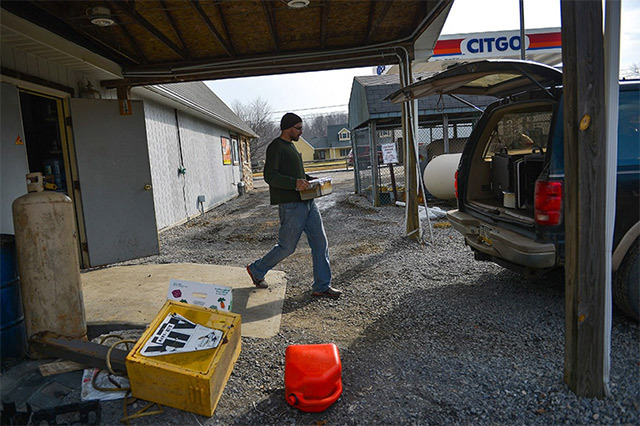The standard of the American bureaucracy

Every day, trucks loaded with documents, drive into a former limestone mine near the town of Boyers, Pennsylvania. Here, at a depth of 70 meters under the ground, organized the largest center for processing pension documents of US civil servants. More than 600 employees manually search through documents, enter data into a computer and print them, carry papers from one vault to another, check the numbers: the procedure has not changed much since 1977.
A huge bureaucratic machine is a division of the United States Office of Personnel Management (Office of Personnel Management, OPM), which draws up the retirement benefit for all. For 35 years, the government has spent more than $ 100 million, trying to automate the process and digitize the workflow in the mine. Each attempt failed, writes The Washington Post. And each time I had to go back to the paper procedure.
An underground repository of government documents at Boyers was established in 1960. Initially, it was considered as a “big safe”, protected from weather and Soviet weapons. First, the processing of documents produced in Washington, and here only sent folders for storage. Subsequently, staff began to be recruited at Boyers - and the main work on document processing was transferred here.
')

Parking in front of the entrance to the mine in Boyers
Almost all the inhabitants of the town of Boyers work in the "federal dungeon." Although there is a good salary, flexible hours and overtime at will, such working conditions cannot be called normal. If you work from 9 to 18, then a few months a year, workers enter the mine before dawn, and leave after dusk. They can see sunshine only on weekends. However, there is no other work in the city, and almost everyone works here before retirement.

Provincial Town Boyers, PA

 Patty DeCaria, 38 years at OPM
Patty DeCaria, 38 years at OPMIndoors you can not cook food and there are no eateries. A representative of a company that delivers pizza every day at 11:30 says people look irritable and unhappy.
The processing of documents is organized as follows. As soon as an employee of one of the state agencies declares that he does not retire (this happens about 100 thousand times a year), the agency collects a package of documents about his seniority and sends it to OPM. Digital documents can not be sent, all you need to print and pack in a special envelope.
At the first stage of processing, documents are checked for duplicates. An employee drives information into a computer - and checks that the person has not retired before. The nightmare of the personnel department is a person who retires for the third time; such cases can “hang on” for several months.
The second stage is usually the longest. Employees must, by telephone, mail, fax or other means, obtain documents that are missing in the file. It happens that for weeks you have to achieve any one signature. Or some documents are in digital form, but they need to be printed out, certified and sent in an envelope.
In the third stage, information is manually driven into the computer. It takes from several hours to two days for each file. The most complicated legislation that has accumulated in the United States over a hundred years requires taking into account many nuances: was the civil servant a military veteran? a fireman? in what three years he had the highest salary? Did he work in the cafeteria at the Capitol? how many worked part-time? By the way, all past automation projects did not work precisely because of so many nuances of legislation and the need to obtain information from various sources.
At the fourth stage, when documents are transported to the next part of the mine, employees check the accuracy of the data entered into the computer. If everything is correct, they, finally, give the go-ahead for a full pension. Prior to that, the former civil servant received only 80%.

At any given time, there are now about 23,500 cases under consideration. The processing of documents in 2014 was reduced to 61 days. The Obama administration has made considerable efforts to reduce this figure from 156 days in 2012. They succeeded, mainly due to the increase in the number of employees in Boyers. Thus, now the processing speed has almost reached the level of 1977 (60 days).
By the way, the affairs of their employees here are processed much faster. There is an unspoken rule: when someone sees a folder with the name of a colleague, they shift it to the first place. So instead of 61 days, the retirement of OPM employees is made in 2-3 days.
A recent study by the Standish Group showed that only 5% of federal IT projects in the United States over the past ten years have been completed successfully. Some were partially implemented, and 41% completely failed, that is, they were discontinued before the introduction phase, writes The Washington Post.
Source: https://habr.com/ru/post/216903/
All Articles